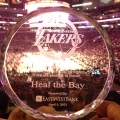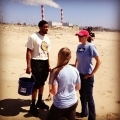Heal the Bay’s Santa Monica Pier Aquarium saw more than 1500 people over the weekend. Visitors bounced between beach cleanups, the BlueGreen festival, and our expo of sustainable innovation held on the Pier deck and the Aquarium — here face painting, scavenger hunts and engaging presentations kept kids happily entertained – not to mention the 100+ species of marine species on exhibit. And some quenched their thirst in Pier establishments serving Golden Road Brewing’s Heal the Bay India Pale Ale (IPA) Some highlights:
- Public Educator Wyatt Miller had all ages in the palm of his hand as he mugged his way through a program called “Who Pollutes?”
- Volunteer Dr. Rene Bombien, put on a lab coat on his day off to play veterinarian with young visitors in the Aquarium’s science lab, where pint-sized vets recorded the “vitals” of various stuffed animal marine sea creatures: oil-slicked birds, sea lions with plastic six-pack rings around their necks and a plastic bag-choked pelican.
- Curby, Santa Monica’s recycling robot, spent Saturday afternoon next to the Aquarium, telling kids about the importance of recycling. A full-sized recycling truck was nearby, where visitors tried their skill at maneuvering the truck’s mechanical arms used to pick up the big blue recycling bins.
- The BlueGreen Festival along the Pier deck’s Central Plaza, was bustling with folks checking out the ocean-inspired art of Heal the Bay partner Erik Abel.
 Sazzi Toe Motion brought their new take on the flip-flop: a sandal (made of 100% recyclable materials) that has multiple toe posts, allowing for better grip for water sports.
Sazzi Toe Motion brought their new take on the flip-flop: a sandal (made of 100% recyclable materials) that has multiple toe posts, allowing for better grip for water sports. - Santa Monica Farmers’ Market volunteers were dishing out delectable organic, in-season fruits and veggies and including recipe cards as a bonus.
- The Aquarium’s Nick Fash and Philip Soza of Golden Road Brewing used their charms to sell eco-mugs made of bamboo — perfect for the debut of Golden Road’s latest brew: Heal the Bay IPA!
Check out more festive photos on the Santa Monica Pier Aquarium Facebook page.
— Randi Parent
Aquarium Outreach Manager






